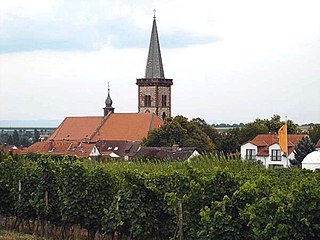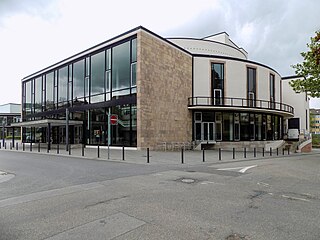12 Sights in Worms, Germany (with Map and Images)
Legend
Welcome to your journey through the most beautiful sights in Worms, Germany! Whether you want to discover the city's historical treasures or experience its modern highlights, you'll find everything your heart desires here. Be inspired by our selection and plan your unforgettable adventure in Worms. Dive into the diversity of this fascinating city and discover everything it has to offer.
Sightseeing Tours in Worms1. Raschi-Haus

The Rashi House is a historic building in the Jewish quarter of the city of Worms. It is located in the south of the synagogue district and has always been an important part of Jewish Worms. In its approximately 800-year history, it has been used in various ways: as a Talmud school, hospital, dance and wedding house, rabbi's apartment and retirement home. Today it houses the Worms City Archive and the Jewish Museum Worms.
2. Alter Jüdischer Friedhof „Heiliger Sand“
The Jewish Cemetery in Worms or Heiliger Sand, in Worms, Germany, is usually called the oldest surviving Jewish cemetery in Europe, although the Jewish burials in the Jewish sections of the Roman catacombs predate it by a millennium. The Jewish community of Worms was established by the early eleventh century, and the oldest tombstone still legible dates from 1058/59. The cemetery was closed in 1911, when a new cemetery was inaugurated. Some family burials continued until the late 1930s. The older part still contains about 1,300 tombstones, while the newer part contains more than 1,200. The cemetery is protected and cared for by the city of Worms, the Jewish community of Mainz-Worms, and the Landesdenkmalamt of Rhineland-Palatinate. The Salomon L. Steinheim-Institute for German-Jewish History at the University of Duisburg-Essen has been documenting and researching the site since 2005. Because of its cultural importance and preservation, the Jewish Cemetery was inscribed on the UNESCO World Heritage List in 2021.
3. Simultankirche Mariä Himmelfahrt
The Simultaneous Church of the Assumption of the Virgin Mary in Worms-Pfeddersheim is a simultaneous church in the Pfeddersheim district of Worms, whose church tower also served as a municipal watchtower and therefore belongs to the city of Worms as the legal successor of the city of Pfeddersheim. The church is a cultural monument due to the Monument Protection Act of Rhineland-Palatinate.
4. Lutherdenkmal
The Luther Monument is a group of statues that was erected in Worms, Rhineland-Palatinate, Germany, to commemorate the Protestant reformer Martin Luther. It was designed and partly made by Ernst Rietschel, and unveiled on 25 June 1868. The monument includes a group of bronze statues on stone plinths centred on a statue of Luther, surrounded by statues of related individuals and allegorical statues representing related towns. The elements are arranged in the shape of a castle, reflecting Luther's hymn "A Mighty Fortress Is Our God".
5. Hagendenkmal
The Hagen monument in Worms commemorates the sinking of the Nibelungen treasure in the Rhine by Hagen von Tronje. It is considered the most important "testimony to the Nibelungen reception that grew stronger in the early 20th century" in Worms and is a listed building.
6. Tiergarten Worms
Worms Zoo is a zoo in the Bürgerweide recreation area in the city of Worms. It was opened in 1972 and is about 8.5 hectares in size. There are 80 species with over 500 animals on display. The focus of the zoo is the keeping and breeding of old domestic animal breeds, such as Glan cattle, colorful Bentheim pigs, Thuringian forest goats and South German cold-blooded horses, which are housed in a walk-in show farm. But exotic representatives can also be seen in the zoo.
7. Das Wormser
The Städtisches Spiel- und Festhaus was a theatre and event building in Worms. It was inaugurated in 1889. The theatre hall was destroyed in the Second World War and rebuilt in 1966 in modern forms. The outbuildings with the catering wing were demolished in the 2000s for the new construction of the culture and conference centre Das Wormser, and the listed theatre hall was integrated into it.
8. Katholische Kirche St. Laurentius
The branch church of St. Laurentius in Worms-Leiselheim is a Roman Catholic church building dedicated to St. Lawrence of Rome. The hall building, which is characterized by the heritage protection style, was built in 1933/34 and is a listed building.
9. St. Peter
St. Peter's in Herrnsheim is the Roman Catholic parish church of the village. It is dedicated to St. Peter and was for centuries the burial place of the branch of the Dalberg family, who lived in the neighboring Herrnsheim Castle. Today, the church is mainly characterized by the Gothic construction phase of the 15th century and by neo-Gothic conversions from the 19th century.
10. Küchler-Denkmal
The Küchler monument in honour of the former mayor of Worms and honorary citizen Wilhelm Küchler stands on Küchlerplatz in the Rhineland-Palatinate city of Worms. It is the first monument erected in Worms in the 20th century that was erected without a military context.
11. Wasserturm ehem. Schlachthof Worms
The site of the former municipal slaughterhouse in Worms forms a monument zone. The slaughterhouse was planned by city architect Georg Metzler and inaugurated on August 12, 1912. It was built south of the Rhine bridge on a 25,000 square metre site. In the 1950s and 1960s, the Art Nouveau buildings on the east side of the area facing the Rhine were supplemented by sheds and extensions, which were later demolished.
12. Magnuskirche
The Magnuskirche is a small church in Worms, Germany, to the south of Worms Cathedral. It is the city's smallest church. Archaeological evidence and its dedication suggest it originated in the 8th century - part of that building survives in the nave's north wall.
Share
How likely are you to recommend us?
Disclaimer Please be aware of your surroundings and do not enter private property. We are not liable for any damages that occur during the tours.










